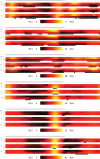Influence of elastic lumbar support belts on trunk muscle function in patients with non-specific acute lumbar back pain
- PMID: 30677095
- PMCID: PMC6345453
- DOI: 10.1371/journal.pone.0211042
Influence of elastic lumbar support belts on trunk muscle function in patients with non-specific acute lumbar back pain
Abstract
Background: A well-known supportive treatment for acute nonspecific back pain, elastic back support belts, are valued for their ability to accelerate natural self-healing, but there are concerns of a deconditioning effect due to their reliance on passive stabilization.
Methods: To evaluate the systematic effects of elastic abdominal belts on the trunk musculature, a total of 36 persons with acute lumbar back pain (no longer than one week) were divided into two groups: an abdominal belt wearing group (B) and a non-abdominal belt wearing control group (C). All were examined over a period of three weeks at three time points: T1 just after assignment, T2 one week later, and T3 further two weeks later. Surface EMG (sEMG) was used to record trunk muscle activation when walking on a treadmill at walking speeds of 2, 3, 4, 5, and 6 km/h. Similarly, pain intensity (VAS) and functional impairment (ODI) over time were recorded in both groups.
Results: Over the observation period, a slight advantage for decreased pain intensity (C: p<0.05 T2 vs. T1; B: p<0.01 T2 vs. T1, p<0.05 T3 vs. T1) and decreased functional impairment (Cohen's d vs. T1, C: T2 0.45, T3 0.86; B: T2 1.1, T3 1.0) was observed for the belt group. For the belt group both oblique abdominal muscles exhibited significantly lower sEMG throughout the observation period (external abdominal oblique muscle: (T1), T2, (T3), internal abdominal oblique muscle: T1, (T2), (T3)) and the sEMG for the back muscles ranged from unchanged to slightly elevated for this group, but never reached statistical significance.
Discussion: The reduced abdominal amplitude levels in the belt group likely result from the permanent elastic stabilization provided by the belt: the required elevated intra-abdominal pressure to enhance spinal stability is then provided by lessened abdominal muscle activity complemented by the belt's elastic support. With regard to the back muscles, the belt, due to its movement-restricting effect, tends to activate the paravertebral musculature. In this respect, the effect of elastic abdominal belts on the trunk muscles is not uniform. Therefore, the present results suggest that the effect of elastic abdominal belts appears to be more of a temporary neutral alteration of trunk muscle coordination, with some trunk muscles becoming more active and others less, and not a case of uniform deconditioning as is suspected.
Conflict of interest statement
The authors have declared that no competing interests exist.
Figures



Similar articles
-
Prescription of Controlled Substances: Benefits and Risks.2025 Jul 6. In: StatPearls [Internet]. Treasure Island (FL): StatPearls Publishing; 2025 Jan–. 2025 Jul 6. In: StatPearls [Internet]. Treasure Island (FL): StatPearls Publishing; 2025 Jan–. PMID: 30726003 Free Books & Documents.
-
Rehabilitation following surgery for lumbar spinal stenosis.Cochrane Database Syst Rev. 2013 Dec 9;2013(12):CD009644. doi: 10.1002/14651858.CD009644.pub2. Cochrane Database Syst Rev. 2013. PMID: 24323844 Free PMC article.
-
Interventions for preventing and treating pelvic and back pain in pregnancy.Cochrane Database Syst Rev. 2013 Aug 1;(8):CD001139. doi: 10.1002/14651858.CD001139.pub3. Cochrane Database Syst Rev. 2013. Update in: Cochrane Database Syst Rev. 2015 Sep 30;(9):CD001139. doi: 10.1002/14651858.CD001139.pub4. PMID: 23904227 Updated.
-
Can lumbosacral orthoses cause trunk muscle weakness? A systematic review of literature.Spine J. 2017 Apr;17(4):589-602. doi: 10.1016/j.spinee.2016.12.005. Epub 2016 Dec 14. Spine J. 2017. PMID: 27988341
-
Yoga treatment for chronic non-specific low back pain.Cochrane Database Syst Rev. 2017 Jan 12;1:CD010671. doi: 10.1002/14651858.CD010671.pub2. Cochrane Database Syst Rev. 2017. Update in: Cochrane Database Syst Rev. 2022 Nov 18;11:CD010671. doi: 10.1002/14651858.CD010671.pub3. PMID: 28076926 Free PMC article. Updated.
Cited by
-
Evaluation of the efficacy of OLIF combined posterior internal fixation for single-segment lumbar tuberculosis: a single-center retrospective cohort study.BMC Surg. 2022 Feb 13;22(1):54. doi: 10.1186/s12893-022-01492-4. BMC Surg. 2022. PMID: 35152902 Free PMC article.
-
The Clinical Efficacy of Platelet-Rich Plasma Injection Therapy versus Different Control Groups for Chronic Low Back Pain: A Network Meta-Analysis of Randomized Controlled Trials.J Pain Res. 2024 Mar 14;17:1077-1089. doi: 10.2147/JPR.S444189. eCollection 2024. J Pain Res. 2024. PMID: 38505505 Free PMC article.
-
Impact of lumbar support on pain reduction in low back pain patients: A systematic review and meta-analysis of randomized control trials.Narra J. 2025 Apr;5(1):e2165. doi: 10.52225/narra.v5i1.2165. Epub 2025 Mar 20. Narra J. 2025. PMID: 40352169 Free PMC article.
-
Effects of External Abdominal Pressure Support on Dynamic Balance: A Randomized Crossover Study.Sports (Basel). 2023 Nov 7;11(11):217. doi: 10.3390/sports11110217. Sports (Basel). 2023. PMID: 37999434 Free PMC article.
-
An Indication-Based Concept for Stepwise Spinal Orthosis in Low Back Pain According to the Current Literature.J Clin Med. 2022 Jan 20;11(3):510. doi: 10.3390/jcm11030510. J Clin Med. 2022. PMID: 35159962 Free PMC article.
References
-
- Bundesärztekammer (BÄK), Kassenärztliche Bundesvereinigung (KBV), Arbeitsgemeinschaft der Wissenschaftlichen Medizinischen Fachgesellschaften (AWMF). Nationale VersorgungsLeitlinie Nichtspezifischer Kreuzschmerz–Langfassung. 2. Auflage, Version 1 ed2017. [cited 2018 nov 21], 10.6101/AZQ/000353 - DOI
-
- van Dieen JH, Cholewicki J, Radebold A. Trunk muscle recruitment patterns in patients with low back pain enhance the stability of the lumbar spine. Spine. 2003;28(8):834–41. - PubMed
-
- Calmels P, FayolleMinon I. An update on orthotic devices for the lumbar spine based on a review of the literature. Rev Rhum. 1996. April;63(4):285–91. WOS:A1996UJ49800010. English. - PubMed
Publication types
MeSH terms
LinkOut - more resources
Full Text Sources

